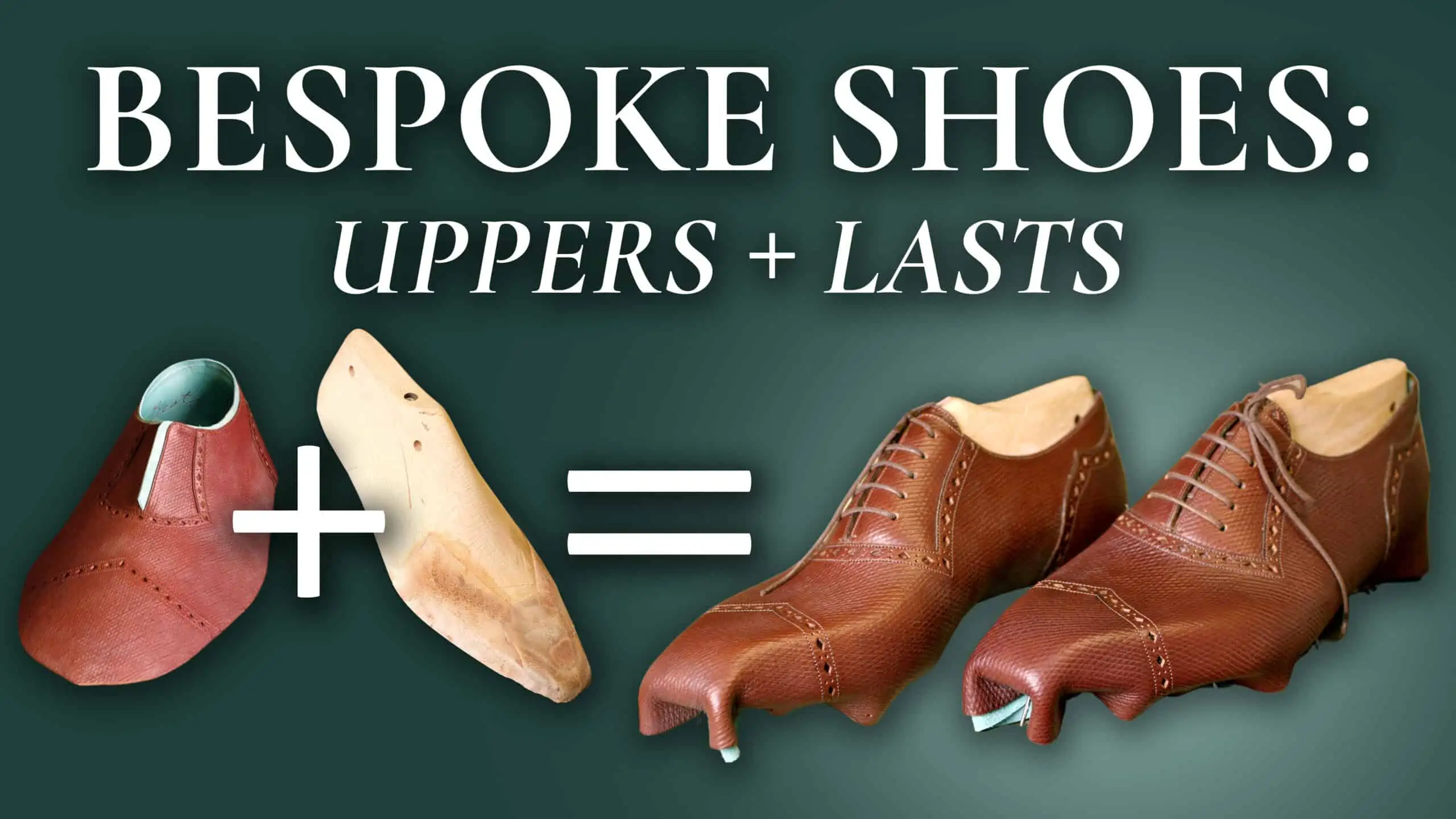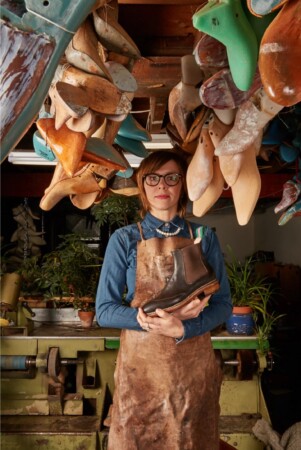In this episode of our series on bespoke shoemaking by shoemaker Amara Hark Weber, we show you how the shoes take their final shape, where the uppers go on to the last and are supported by the heel caps, the toe puffs, and the sideliners to give the shoe the structural integrity it needs.
- “First Lasting” – Pulling the Uppers Into Shape
- Structural Pieces: Heel Cap, Toe Puff & Sideliners
- Preparing & Skiving the Structural Pieces
- Removing the Uppers from the Last
- Adhering the Heel Cap
- Inserting the Sideliners
- Re-attaching the Uppers to the Last
- Trimming & Adhering the Uppers to the Insoles
- Adhering the Toe Puff
- Smoothing the Toe Puff
As you might recall, making the uppers by hand was quite a feat. So, what’s so difficult about putting uppers on a last, and why does it warrant an entire post? Actually, it’s more complex than you might think, so let’s get into it.
“First Lasting” – Pulling the Uppers Into Shape
Right now, the uppers consist of the upper leather and the lining. Pulling the uppers of the last can happen in three ways. The first one is what is called “wet lasting.” The second is called “dry lasting,” and the third one is a combination of both. Wet lasting versus dry lasting is a major debate in the shoemaking world, but there’s no obvious right choice.
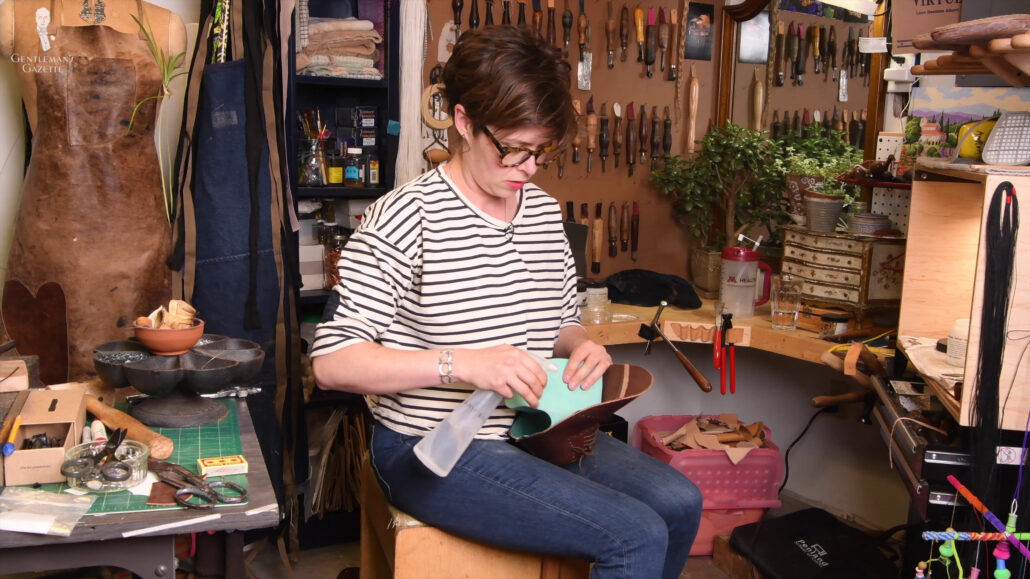
Amara knows both methods, but for this pair of shoes, she uses a combination of dry-lasting and wet lasting. Why is that? Well, she adds the water in areas where she wants extra malleability, and she leaves it dry in areas where she doesn’t want that. In that sense, you get the best of both worlds. Your shoemaker will do whatever they’re most comfortable with or what they think is right in a particular situation.
Shaping Bespoke Shoe Lasts by Hand & Machine
Now that the uppers are wet. Amara applies some baby powder to the last to prevent the lining leather from sticking to the last. Using the cobbler’s pliers, Amara uses the tip of the shoe to align it with a center line and pull it over the last. This is a very visual process.
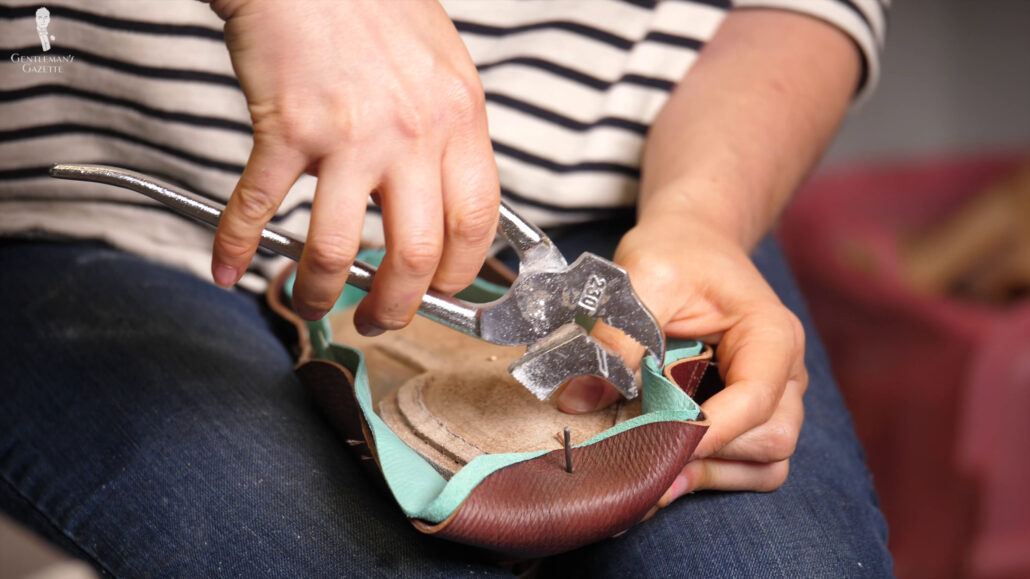
Once she thinks it’s in place, she tacks the uppers down under the last. Since the uppers have two layers, the lining and the uppers, Amara pulls each layer separately to allow for a really tight fit without any excess wrinkles. If you don’t do that, the wrinkles later will look unsightly and create discomfort for the wearer.
Now that the front is in place, Amara keeps pulling on two layers of leather and tacking it to the shoe. While tacking the uppers in place, there’s a constant visual inspection, and if she sees something is off, she might remove a tack or two or more and redo it just to make sure everything is the way she wants it, without any lumps or wrinkles or any irregularities. By inspecting and correcting your work, you prevent any bigger problems down the line.
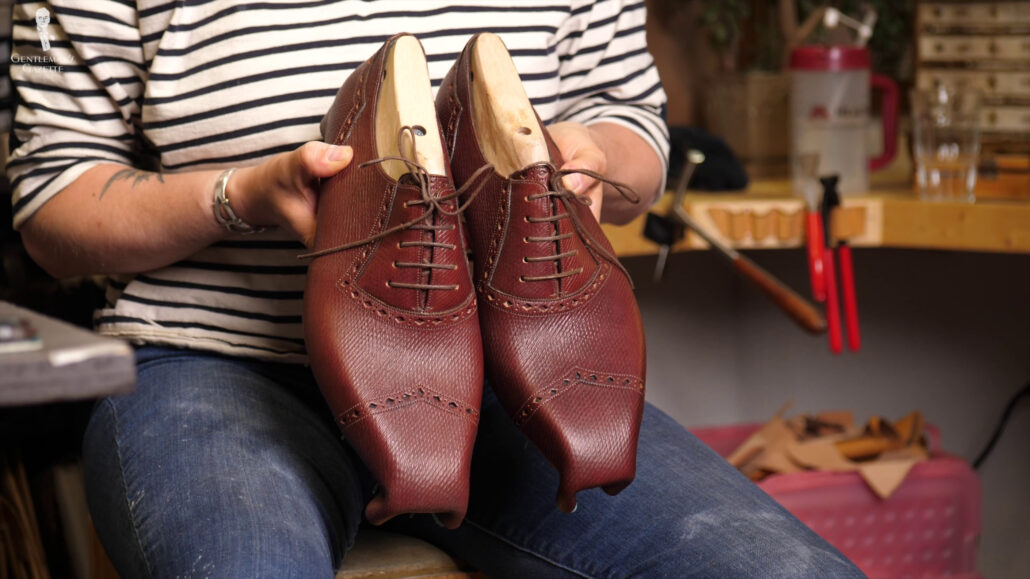
Once she’s done with one last, she moves to the other. As you might recall, it’s not too obvious because, sometimes, she’s working on both sides at the same time, but not so here.
After both shoes are lasted for the first time, they will need some rest to remember the shape of the last. Yes, unlike fabric, leather really has this unique ability to remember a shape that it’s pulled onto, and yes, the water really helps to keep that shape. That’s why she uses it in the first place.
Structural Pieces: Heel Cap, Toe Puff & Sideliners
So, now that the uppers are getting acquainted with their new shape, it’s time to work on the structural pieces – that is the heel cap, the toe puff, and the sideliners.
So, why do you need these pieces? Well, for two reasons. Number one: they provide structural integrity. Let’s say someone steps on you, the shape of the shoe will pop back in place and not look ruined. These pieces also provide additional support for your foot. For example, the stiffer heel cap makes walking around much more comfortable and gives you stability when you walk.
To say it in Amara’s words:
The toe puff and the heel cap will do a couple of different things. They help to keep the shape of the shoe, they help to keep the shoe on your foot, and they protect your foot.
Amara Hark Weber
I’ve cut apart quite several quality ready-to-wear and also some bespoke shoes, and typically, what I’ve found is that most even higher-end ready-to-wear shoes have the heel cap and the toe puff, but most often, they do not have sideliners. Typically, bespoke shoes and higher-end, ready-to-wear shoes like Edward Green feature sideliners.
Are Edward Green Dress Shoes Worth It? (English Shoe Review)
So, what’s the benefit of sideliners? Well, they’ll also give you more structure on the inside and the outside, but they also prevent your little toe shape from poking through on the outside of the shoe. That’s something you’ll often see in ready-to-wear shoes. And why? Well, they don’t have sideliners.
The sideliner pieces give you a little bit of extra structure. They make sure that your toes don’t kind of poke out. It’s just a little bit of extra structure and protection so that, the entirety of the shoe, the most flexible point is across the break.
Amara Hark Weber
This ensures that the shoe bends naturally with your foot. This reduces excess wrinkles and creases and allows the shoe to bend and fold in the areas it is supposed to.
The heel caps Amara was making for this pair of shoes were much bigger and longer than the ones I typically see in ready-to-wear shoes. You can just see it with a bespoke shoe. It is made for you, and it’s very much thought-through and designed for your foot. They’re so long that they include some arch support. Pretty cool, isn’t it?
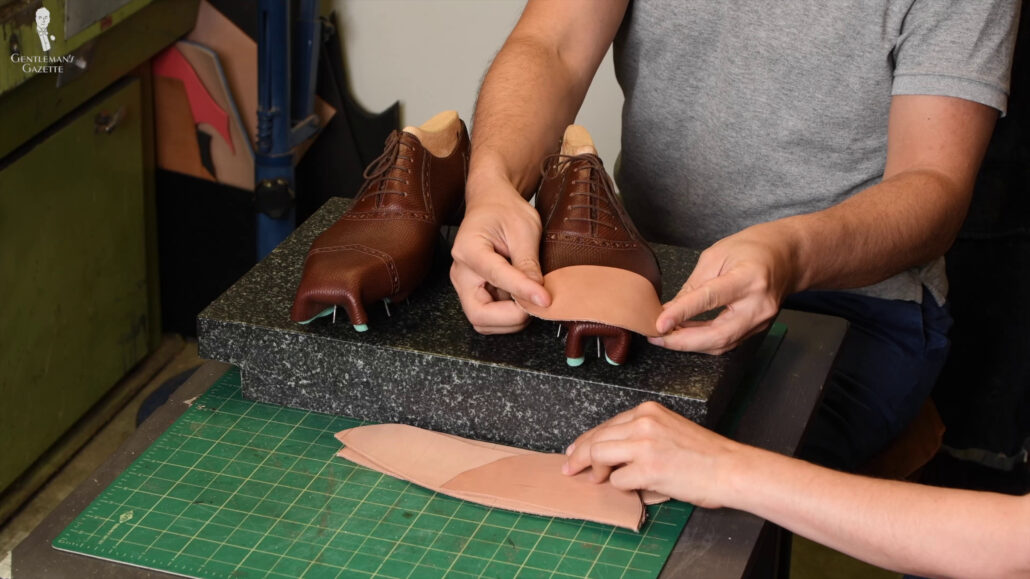
For a bespoke shoe like this, Amara cuts the toe puffs from the same leather as the insole. So, it’s a very stiff, solid, and robust leather. To wear shoes often, I see them being made of a thermoplastic material that takes the shape when it’s heated, so it’s very quick to work with. With a bespoke shoe, on the other hand, the focus is on quality and the utmost result, so it’s typically made of all leather.
As you recall, the insole is quite a thick piece of leather. And so, your shoemaker will skive it down so it won’t be as thick. But, the core strength and robustness are still there. In contrast to this, the sideliners are made of a thinner, much more flexible leather because there, you want the shoe to be a bit more flexible and able to bend. As you can see, everything has its purpose.
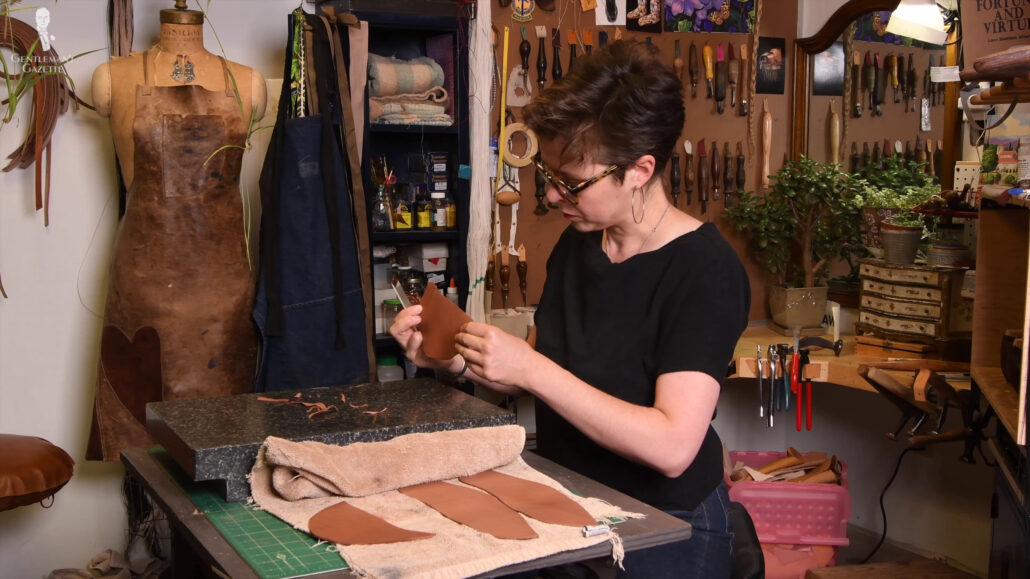
Preparing & Skiving the Structural Pieces
So, how are these pieces actually skived down? Interestingly, Amara soaks them first in water, so they’re really wet. She does that to make it easier to work with them, but they don’t have to be soaking wet. That’s why I should pass them dry.
All of these pieces will be skived to the perfect depth and feathered along the edges so there will be no harsh lines later on. These pieces will sit in between the leather and the uppers, so pretty much right next to my foot. Therefore, they have to be as thin as possible so it doesn’t have an impact on my comfort or it irritates my feet.
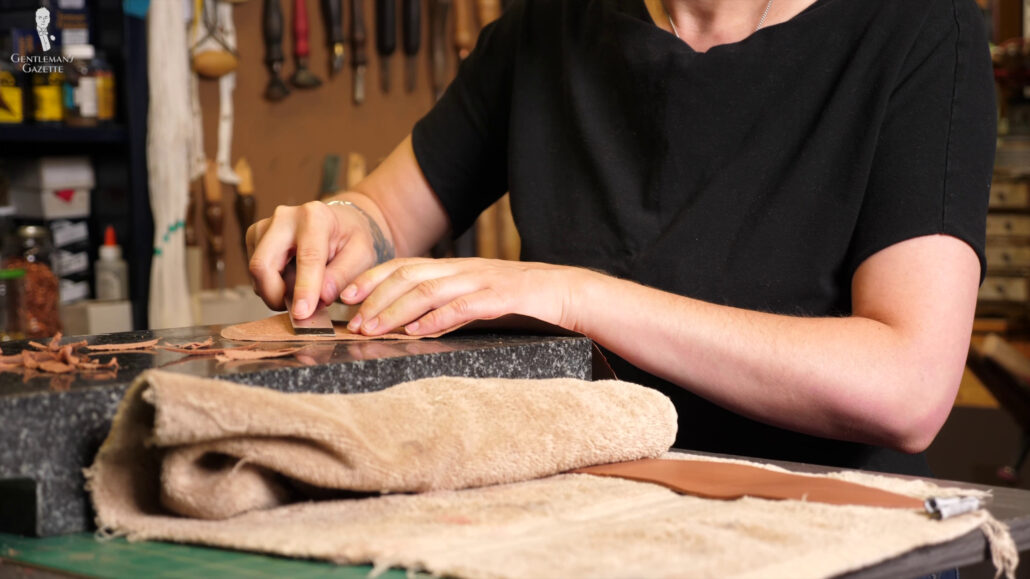
Amara starts by hand-skiving because it gives her the most control, especially on the angle. Later down, she flattens the middle part with the machine because that’s faster and it works, and then she works at it again by hand.
Your shoemaker may do it all by hand or all by machine, depending on what they’re most comfortable with. The machine is definitely faster and, therefore, more efficient. By hand, you just get more detailing.
Removing the Uppers from the Last
Now that the uppers have had enough time to rest and all the structural pieces are finished. It’s time to take the uppers completely off the last.
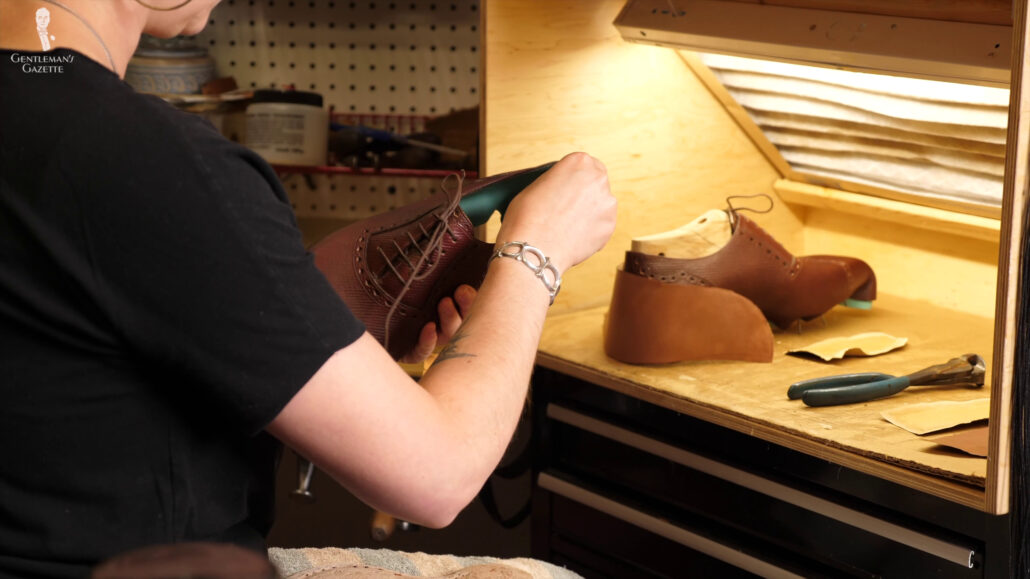
Why so? Well, those structural pieces have to go in between the upper layer and the lining layer and you can’t do that while it’s on the last. I mean, it’s incredible how well the leather keeps its shape even though it’s completely off the last, isn’t it?
Amara gently runs her fingers over the interior just to feel if any wrinkles or lumps have formed while the whole thing was resting on the last.
Adhering the Heel Cap
After ensuring everything is smooth, Amara now takes that heel cap and just bends it onto the last heel, and you can see it already takes that shape rather easily. She really pulls it off the last and smooths it down with her hands.
In the next step, Amara applies a special paste to that heel cap, which helps as an adhesive to basically glue it to the interior lining into the uppers. But, once it’s dry, it also stiffens the heel cap to get the desired structural integrity. Here, you can really see how that heel cap is sandwiched between those two layers of leather.
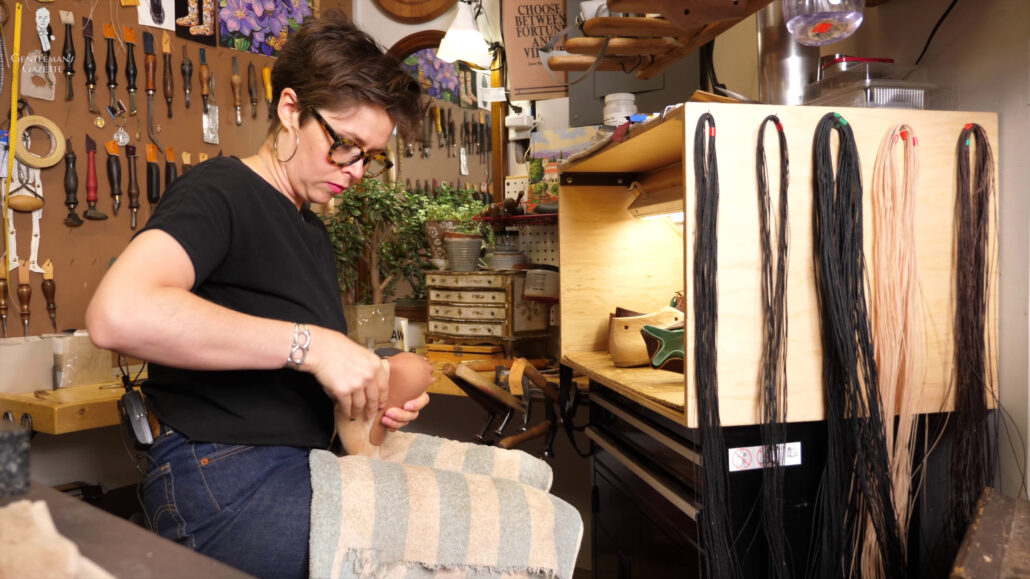
Now, you can see you’re adding a bit more paste. Now, no, she doesn’t want there to be any runny excess or lumps, but she wants there to be enough that the adhesive properties are ensured for life. As she says, “Not too much, not too little. It’s just enough.”
Inserting the Sideliners
Next, it’s time to glue the sideliners in place. And interestingly, Amara wets her hands repeatedly to get rid of any excess glue that might dry on the uppers. Very nice attention to detail that I found very satisfying to see.
It’s then time for inspection of the entire shoe. If there are any wrinkles, Amara removes them by pushing with her hands. As the glue is now hardening and connecting all these expensive layers of leather, we come to a critical juncture.
So, now, we’re really playing for keeps. This is where you can go back and undo stuff, but it’s pretty unfun.
AMara Hark Weber
If there’s anything you want to be changed about your shoes, it’s good to do that before that point.
Re-attaching the Uppers to the Last
To help a structural heel cap and sideliners really get into shape, it’s best to put the uppers with those structural elements back onto the last, so that means re-lasting the shoe.
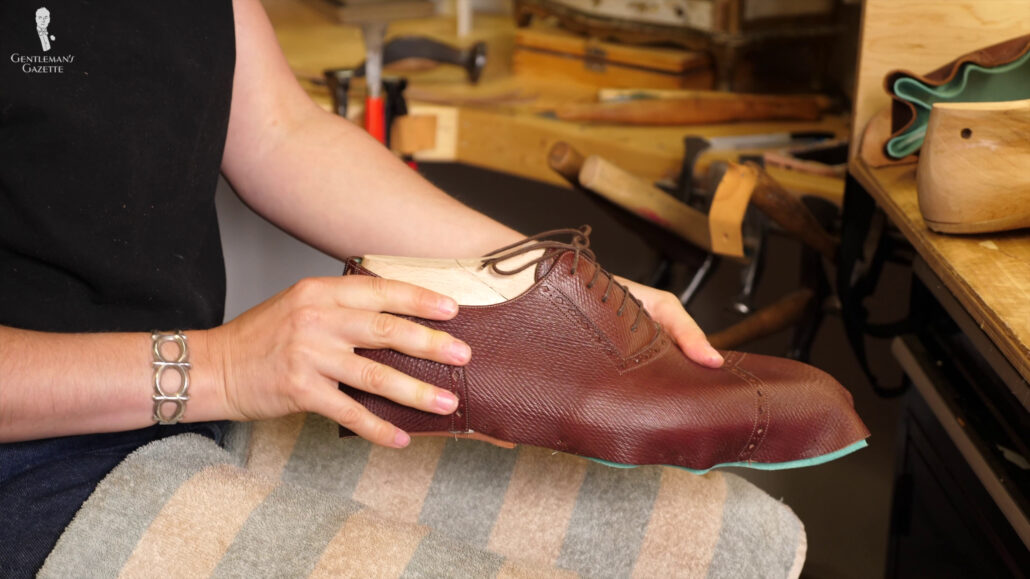
Again, Amara inspects and compares both shoes to ensure everything looks right. Obviously, your final shoe won’t have any nails or tacks in it.
Trimming & Adhering the Uppers to the Insoles
It’s time to really adhere to hold uppers to the shoe. After removing the nails one by one and maybe even cutting off some excess leather, the leather pieces are adhered to the bottom insole with a paste. You can see she constantly uses her mallet to keep everything really well-adhered and wrinkle-free.
As you can see, she uses sharp knives and snips to get rid of any excess leather because everything has to lay smooth and more is not better in this case. It’s much worse. The superfluous leather could leave irritating lumps and just add bulk and create a less elegant shoe.
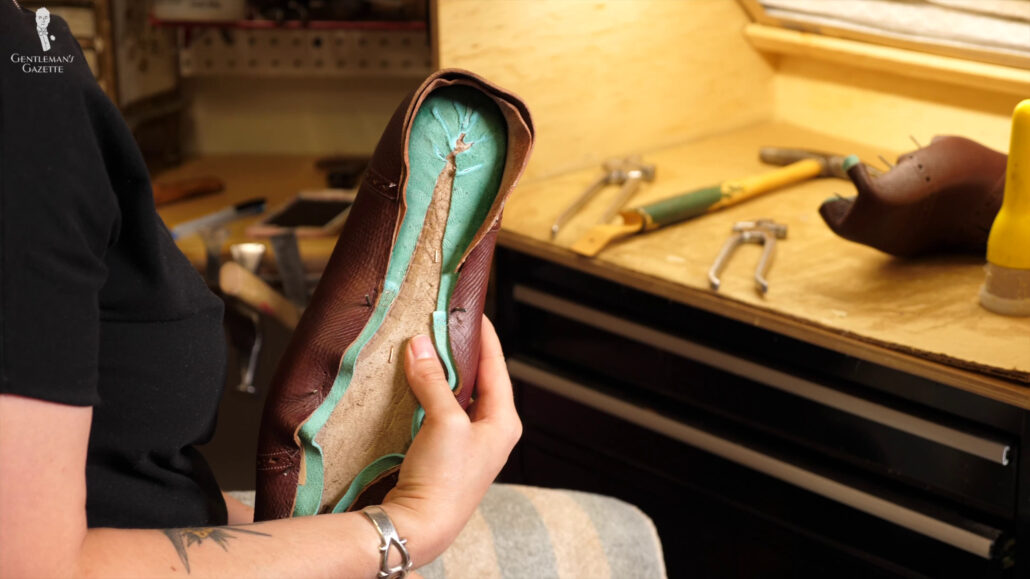
Here, you can see how the lining is glued down really neatly. And that’s the first step. You start with a lining and then a second step. The uppers follow. So, everything is glued in place very carefully and accurately. To do that, she applies some paste on the inside of the uppers. She then pastes them to the insole and further ensures it’s all in the right position with tacks. And, of course, how could it be any different, the mallet?
Amara also carefully tacks down the entire perimeter of the heel just to make sure there is a tight fit. As you can see, there are a lot of nails here because it was a thicker, stronger leather, so she wanted to ensure everything remained in place.
Amara is paying special attention to the area on the heel, which is also known as the “heel cup” because that’s where the heel is later going to be attached to. And by paying more attention now and keeping everything flat and level, will make it easier when the heel is built up later on.
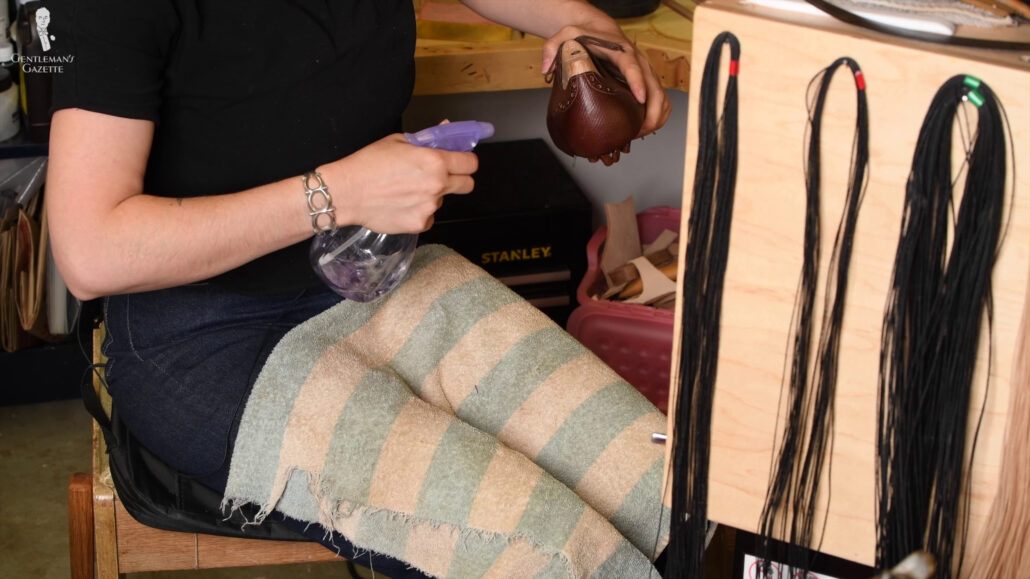
Here and there, she sprays a little water to help with malleability. In this process, she does one shoe after the other, but because leather is a natural product, it will never feel the same on both shoes. There’s always a subtle difference between the shape of the leather, the structure of the leather, and other factors.
Amara said, “One is always easier than the other. This is tough. You always have the first one that’s going to be harder.”
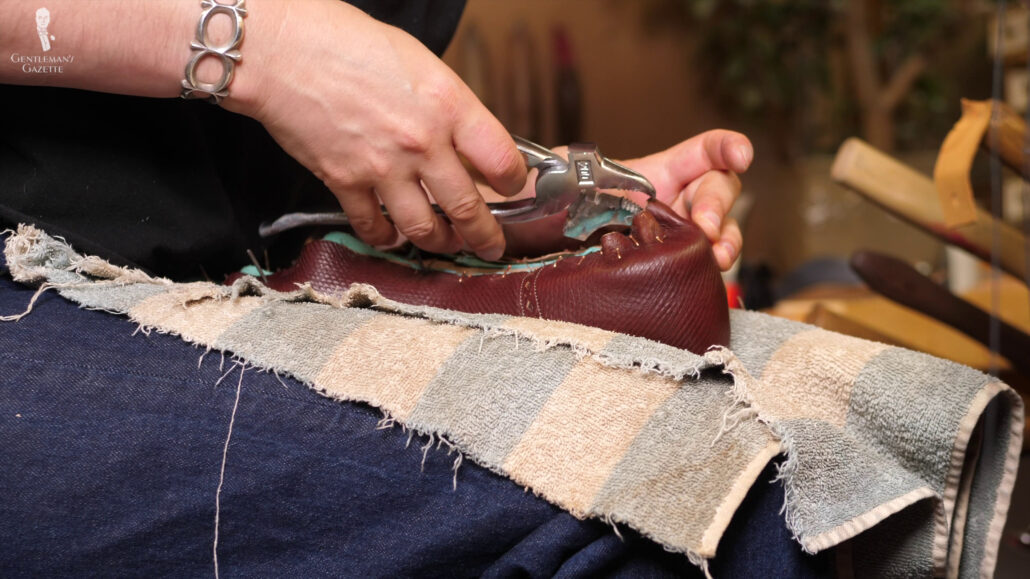
Obviously, many tags are being used while the glue is drying. Amara calls it a “snaggletooth Cinderella.” Don’t worry; all these tags will be removed once the glue is dried, and then the fine detail work can begin.
Occasionally, you can see Amara hammering down on the last itself. This is to ensure it is seated flush against the uppers to ensure a tight fit later on. Eventually, every layer has to be glued to the bottom of the insole.
Adhering the Toe Puff
Last but not least, it’s time to add the toe puff. Amara carefully peels off the outermost upper leather layer in the toe area, while leaving the lining on there, and in between goes the toe puff.
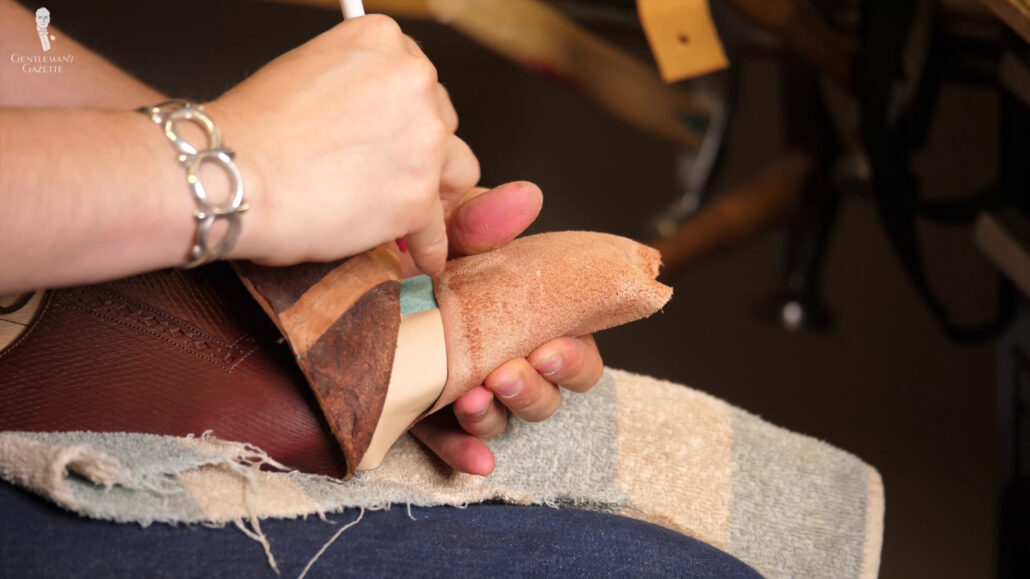
First, she marks the outer edge of the toe puff, so she knows where to apply the paste. Again, the same procedure – glue, tacks, and hammering with a mallet. Soon, Amara will need more time to really smooth and thin out that toe puff. Why? Well, the flatter she can make it now, the easier it will be for her to do her job later on. But, once she’s done, she moves into the other shoe and constantly inspects and compares the two.
Now that Amara is doing that, she could see that one shoe was minutely more different than the other one. But it was much easier to spot that while they were on the last. Why? Well, the shoes are probably straight-aligned, and you can look at them in every angle you wish. When the shoe is worn or moving around, it is much less noticeable. But remember that the linings were off in this part because we’ll come back to it later.
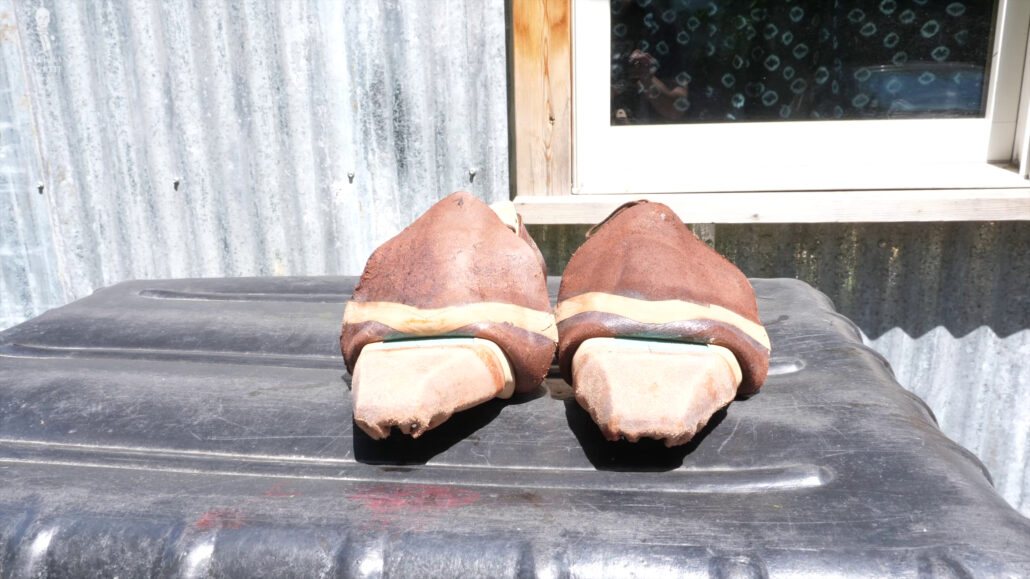
The toe puff also needs some time to rest and really adapt to that shape.
Smoothing the Toe Puff
Now that the toe puffs have gotten into shape. It’s time to work on them and smooth them out. By doing that, the wearer later experiences maximum comfort, and you also get a better look at the toe cap.
First, she removes the tacks and then cuts off excess leather by hand, and then, it’s followed by a machine treatment. A precision grinder here really helps to get everything smoothed down the way she wants it to. As you can see, Amara is still inspecting and comparing both shoes, so nothing is different, but both are the same.
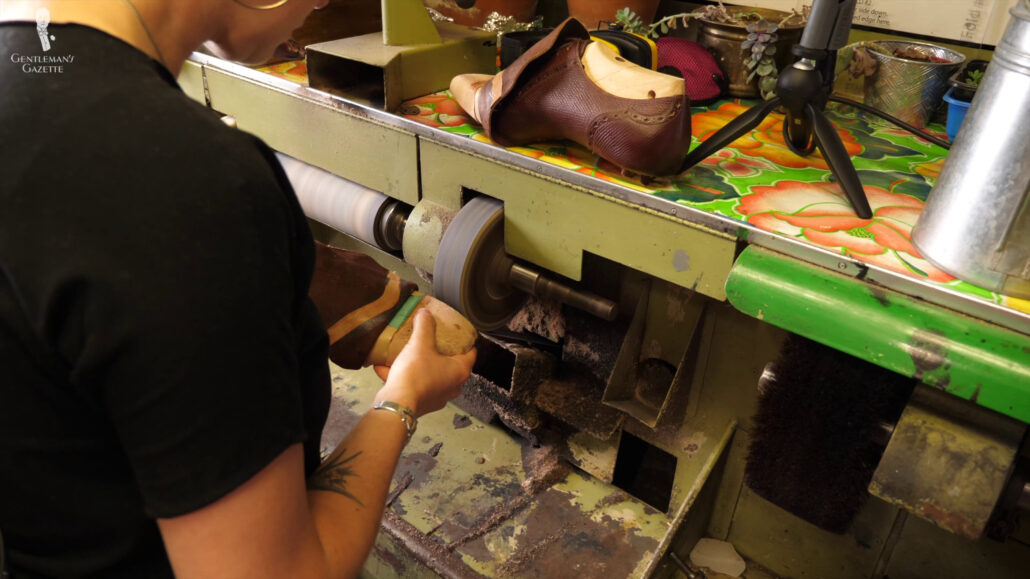
So, how does Amara know that she’s done with the work and she’s gotten the toe puffs in the perfect shape? She puts it this way: “The question of how do you know when it’s done is a good one. I work till I think it’s done, and then I work a little more.”
Once she’s done with all the fine work of smoothing, she can apply some paste to the toe puff.
At this point, the upper leathers can be fully applied to the last. Once again, she stretches it and tacks it in from the bottom. The uppers are now fully in the last, and she wipes them up with water to get rid of any detergents. You can see her hammering away a lot of times on this shoe. She really likes that mallet.
The thousand tiny taps. They really make a difference though… So, the nicer, the crisper I can make this heel seat, the nicer it will be in the end, which is why I keep coming back to it.
Amara Hark Weber
Around this time, Amara figured out the reason she was having a harder time with one shoe than the other was that the leather textures were quite different. One leather texture was simply stretchier than the other, and it impacted quite a few things. For example, the lines in the shoes varied slightly. Of course, no leather piece will ever be the exact same as the other.
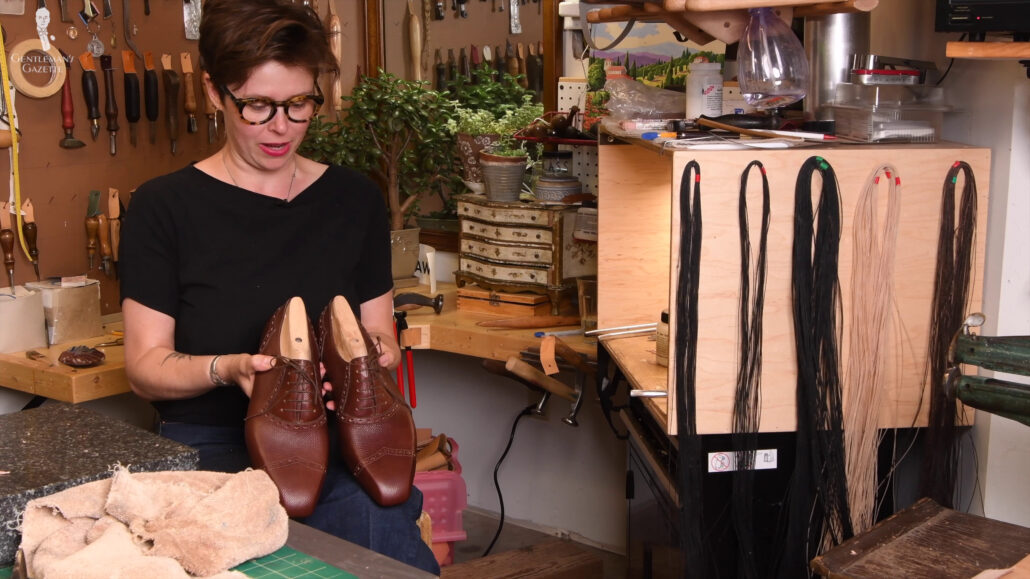
Typically, for bespoke shoes, there’s less of a variance because the shoemaker takes very great care and attention to detail during the cutting process, trying to understand what the different leather textures are then, so it doesn’t come back to haunt them later on at this stage.
Now that the uppers are on the last, it’s almost time to attach the soles. But, before that, we need a welt strip, a shank, and a filler material made out of cork before that can happen–and we’ll show you that in our next installment of this series!
What did you find to be the most interesting part of this stage of the bespoke shoe process? Share with us in the comments below!
